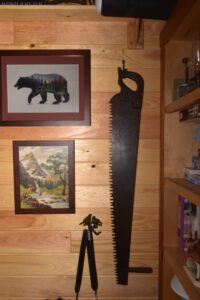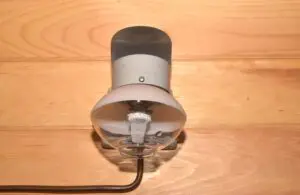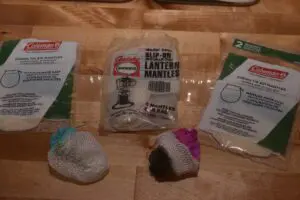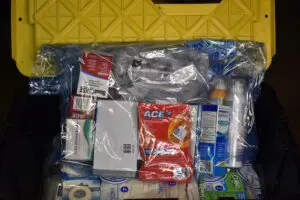SHTFPreparedness may collect a share of sales or other compensation from the links on this page.
For the past 5 years, we have been the proud owners of a vacation camp that plays double duty as our bug out location. Most of our friends know this as our little cabin in the woods. To a select few, it serves double duty as our bug out location. With this added responsibility in our lives, we take extra care to ensure we keep it in good working order and well prepared for if the SHTF. We take stocking your bug out location seriously.
In this article, I’ll cover the manner in which we stock ours and, to some extent, with what do we stock it. I believe we have taken an approachable method to stocking your bug out location that balances cost and reason, considering the threats we see on the horizon. That being said, you may have a different threat and a different worldview. This may take you in a different direction. Everyone must find their own balance when it comes to bugging out and the location you plan to escape to!
The Dual Use Bug Out Location
It’s hard enough to own a second property. Let alone one that you purchase, then improve as a bug out location, without using it. I understand the advantages of having a bug out location with the appearance of vacant land. It attracts less attention, and therefore will be less of a target if things go sideways.
In our case, we planned on using our property as a vacation, or camp spot. We wanted a parcel that we could visit frequently, especially during the summer and fall. This placed a few requirements on its size, structure, and layout. We needed something 3 or 4 seasons with enough land to roam and hunt or fish.
Additionally, to be convenient, we needed it close enough to drive to on the spur of the moment. As you look for a vacation property, keep these practical matters in mind. If your dual use property is too far away, you won’t go there as often as you like. If there’s nothing to do, no land to walk or fish, you’ll get bored and stay home.
Further, we wanted it as a bug out location. This placed requirements on the location as well as local resources. It had to be “off the trail.” We wanted more trees than neighbors. Our requirements for location reduced it to 30 minutes off a highway. More specifically, it needed to be on a back road that was off a back road, that was off a forgotten road. You get the idea. It needed to be remote.
Finding a dual-use property is a delicate balance of requirements. In most cases, it is a good use of your time and money. Consider it.
Concerns With Stocking Your Bug Out Location
Assuming you will not be occupying your bug out location every day, there are a few considerations that you need to be aware of.
First is temperature. Unless you have underground storage, the temperature will vary throughout the year. High temperatures during the summer and cold temperatures during the winter. Temperature changes are the enemy of most stored goods. From food to ammo, temperature changes cause degradation. While it may not be immediately fatal, you will need to rotate on a quicker schedule.
Next is the risk of holding all your eggs in one basket. As was our case, you may be limited in the size of your property. Our camp is a modest 700 square foot building with no basement. This means we make every square inch count. While we have all the critical storage on site (e.g., 30 days of food), I would love to have more.
The lack of space means we need to be creative. This includes the ability to move a lot of supplies all at once in the case of an emergency (we have this). This may also include storage at a secondary location, such as a storage facility.
Finally, if you have set it up as a dual use property, consider your mix of long-term and short-term supplies. In our case, we have mostly short-term supplies. We work through these (e.g., canned foods) and replenish them on a weekly basis. The long-term supplies are also kept there. However, we bring them home when we close up for the winter.
Stocking Your Bug Out Location: Categories
For any task as big as stocking your bug out location, it’s best to get organized. I’ve chosen to organize by survival priorities, including shelter, light and heat, water, food, medical, and security. This logical breakdown allows us to compartmentalize our stocking efforts into categories that may overlap with our own non-bug out preparations.
Shelter
The first survival focus is shelter. This is the roof over your head and the means to keep it weather tight and comfortable. In a pure interpretation, shelter is the means by which you are able to maintain your body temperature.
The Roof Over Your Head
Stocking your bug out location for shelter means ensuring you have the tools and supplies to keep the roof up, and the rest of the place weather tight. This means tools and supplies.
Stocking up for shelter will depend on several factors that will be specific to your site. First is age and quality. Newer roofs and windows should have fewer issues than older structures. Likewise, a building with trees around inherits risk from the trees. Last, risks extend to the weather. Have the gear to repair your shelter in the event of an ice storm, hurricane, or other severe weather.
Gear means tools and hardware. Saws, hammers, nails, plywood, screw guns, and tarps (for temporary weather seals) should be in your stores. Further, and I really shouldn’t need to say this, but make sure you know how to use your tools and have a plan for sealing up every window, door, and the roof.

Manual tools are placed around the cabin as “decoration”
Spares
Finally, you must have spares for your shelter. This includes material for fixing and maintaining the structure as well as those items inside it.
We store a small supply of 2x4s and plywood if we need to board up the windows or patch a hole in the roof. Similarly, we have a collection of consumables. This includes spare parts for the water systems (filters for the Berkey and leathers for the pitcher pump), gas lamps (extra mantles), electrical (outlets, switches, and breakers) and plumbing (fittings, valves, and pipes).
Take a walk around your house and property and list off everything that may need to be replaced in 1 year, 5 years, and then 10 years. You don’t need a lot, but that extra length of plumbing copper or window glass will be indispensable when the stores are closed forever.
Stocking Your Bug Out Location: Shelter
Here’s a quick list of supplies you should consider for your bug out location’s shelter system.
- Tarps
- Plywood
- Tar paper
- 1-2 bundles of shingles – or 1-2 sheets of metal roofing
- 2x4s 2x6s, 2x8s
- 1-2 rolls of insulation
- 1 roll of plastic
- Window glass or plexiglass
- Nails-all types, screws-all types
- Duct tape
- A complete tool set including
- Hammer, pry bar, screwdrivers
- Socket set and crescent wrenches
- Pliers
- Drills
- Saws
- Tape measure
- Plumbing supplies
- Electrical supplies
- Spare parts for all major systems-electrical, water, other
Light and Heat
Next on the survival list is light and heat. Light is mostly a convenience. Without power, we learn to rise and sleep with the sun. That being said, I hate fumbling around in the dark. I much prefer a little light once the sun goes down.
The average person can last for a few hours without maintaining their body temperature. Hypothermia can set in faster than you may recognize it. Once you dip a few degrees, it’s impossible to come back. A heat source, or sources, is vital if you live in an area that gets below 40 or 50 degrees Fahrenheit.
Let’s look at socking up your bug out location for light and heat.
Banishing The Dark
As stated, light is a convenience. But as with most conveniences, it makes life so much better when it’s there. In our case, the original owners outfitted the camp with gas (propane) lanterns. I absolutely love the quality of these lights. That being said, gas lamps are a workable light, but it isn’t directional or task lighting.

We soon added a solar system with 480 watts of panels and 600-amp hours of batteries. The primary goal of this system was to provide light. There are several side benefits such as electric fans on warm nights and the addition of a refrigerator, however the primary purpose was light.
The stocking of your bug out location for light includes the consumables and fuel. Gas lanterns use mantles to generate light. They are cheap, stock up on them. For electrical systems, you will need bulbs. LED technology has made this much easier as LED bulbs don’t burn out nearly as often as their incandescent cousins. We have two bulbs per outlet on hand. In an emergency, we would only need one half to one third of the lights operational.

Spare mantles for the gas lamps
Next is fuel. For us, that means propane, sunlight, and lamp oil. We have several oil lamps and keep several gallons of lamp oil on hand. Propane does not have an expiration date and neither does lamp oil. So stack them deep. As stated above, we have three 100 gallon propane tanks that will last us years.
98.6 Degrees
The primary goal of your shelter is to keep you warm. In extreme seasons, your shelter may need a little help. This means fire.
Man’s relationship with fire goes back thousands of years. While it may not be in the same forms today as it was back then, if the grid goes down, we will have to return to those ways soon enough.
Your shelter should have redundant sources of heat. This can be a wood stove, fireplace, gas heater, or solar heater. Regardless, have more than one and keep it maintained. For fireplaces and stoves, keep the flue clean and inspect the stove for leaks. Carbon monoxide is a silent killer.
Don’t neglect the ability to cook. Even a warm bowl of soup or cup of hot coffee can raise your internal temperature. Extend your concept of heat to kitchen stoves, grills, and rocket stoves.
Fire also means fuel. Wood, propane, or kerosene are some of the most popular fuels. Wood grows on trees, therefore you must have a way to harvest it. This means chainsaws, splitter, axe, and saw. Have the tools to gather the firewood you need.
If you are storing other fuels, know their lifespan. Propane and kerosene will last years while gas and diesel need to be treated to have a life beyond 6 months.
Run the math on how much you use and have enough to get you through your expected dry spell. In our case, we use a little wood, so it’s easy to have a three-year supply. Regarding propane, our last 100-gallon tank lasted over 3 years. We should get close to 10 years from the three that are currently hooked up. That being said, if we have to move in full time, the use will go up, but I still expect to have more than a year in both wood and gas.
Stocking Your Bug Out Location: Light and Heat
Here’s a quick list of supplies you should consider for your bug out location’s lighting and heating systems.
- Light bulbs, mantles, and wicks
- Spare lanterns, light fixtures
- Lamp oil, propane, kerosene
- Chainsaw, handsaw, and axe\hatchet
- Maintenance tool (chain sharpener, sharpening stone, bar oil, 2-cycle oil, gas stabilizer)
- Stove cleaning supplies (e.g., chimney brush)
- Fire extinguisher and chimney fire “log”
- Fuel (wood, propane, etc.)
Water
The rules of survival state that you can last about three days without water. It’s a good rule to go by and it defines the very importance of having multiple sources of water at your bug out location.
The primary source should be convenient and potable. This usually means a drilled well, however, it can also include a cistern. Our camp has a cistern. Cisterns are shallow well that are usually open to the air and collect ground water. This is in contrast to a drilled well that is sealed from ground water via a metal casing. These wells are dug through clay and rock into the aquifer.
The disadvantage of cisterns is that you must treat the water prior to drinking. Most drilled wells are ready to go once you have the water out of the ground. As our cistern is the primary source of water, we have a routine of boiling and filtering any water used for washing or drinking. A ten-minute boil and a trip through the Berkey suffices to make the water potable.
Additionally, we chlorinate the cistern with one tablet of pool chlorine (no additives, just chlorine powder). This treats most of the nasties in the water and also clarifies it.
Secondary Sources and Spare Parts
It is imperative that you have a secondary source. Most likely, this will be a pond, lake, or stream. Just like a cistern, you will need to treat this water to ensure its safety.
Stocking up your bug out location for potable water will rely on any spare parts and chemicals you may need to keep things safe. Include pump leathers, and spare plumbing parts for your specific water system. Chlorine is easy to store in powder or tablet form. Liquid chlorine only lasts about 6 months. If you go the filter route such as a Berkey or Sawyer, stock up on several extra filters. Luckily, most last for thousands of gallons.
Stocking Your Bug Out Location: Water
Here’s a quick list of supplies you should consider for your bug out location’s water systems.
- Water purification chemicals (chlorine tablets)
- Spare water filters
- Pump maintenance supplies (leathers, plumbing fittings, foot valve)
- Buckets and yoke for carrying water
Food
Next on the list is food. I’ll admit, it’s my favorite category and I have the shape for it. I’m also blessed with a family that enjoys cooking. We store approximately 30 days of calories at our camp and a fair bit of that is short-term food.
To balance this out, our bug out plan includes moving a lot of our long-term food up with us, via trailer, during the evacuation. If we have notice of tough times, then the food goes up much earlier.
Regardless of your plan, stocking your bug out location for food should comprise both short-term and long-term items.
Long and Short Term Storage
Short-term foods include canned goods, dried fruits, sauces, jellies and jams, unsealed flour and yeast, as well as any snack foods. These are valuable food items that, if you have to tap into them when the SHTF, will add variety to your meals. You should rotate any short-term items annually.
Long-term storage items are the prepper staples that are packaged up for extended periods of time (think decades). Beans, rice, oats, pasta all packaged in 5-gallon buckets and mylar are the ticket here.
The location of your bug out location will determine the handling of your long-term foods. In our case, we do not go in during the winter because of many feet of snow on the road. Therefore, we only bring in a few buckets for the spring, summer, and fall. We then return them during the late fall back to our primary residence. As stated, if we need to bug out, we have plans to take up a trailer load (approximately 50 buckets) of our long-term storage items.
If you don’t want to run the risk of a quick bug out, then I highly recommend either making room for sufficient long-term food or investing in a local climate controlled storage center.
Next, when stocking your bug out location, don’t forget comfort foods and spices. Comfort items include foods such as sweets, chocolates, chips, and other treats. Maybe include a bottle of wine or two. You won’t be living off these items, but they will brighten up your day when you break them out.
Stocking Your Bug Out Location: Food
Here’s a quick list of supplies you should consider for your bug out location’s food.
- Canned fruits
- Sugar, flour, baking soda and powder
- Canned vegetables
- Dried fruits and vegetables
- Jellies and Jams
- Pasta
- Canned meats
- Freeze-dried meals
- Long-term stored rice, beans, oats, pasta, wheat, flour, cornmeal
Medical
Stocking your bug out location with medical supplies is critical when you realize you are your own first responder. Most locations worthy of a bug out are remote. Remote means medical services are minutes away when seconds count.
In our case, it’s a 10-minute drive to the closest location for cell service. This location is also right next to the safety complex of our little town, so it’s a bit of a wash time wise. That being said, it’s an all-volunteer emergency squad, so there is still the time delay getting the team to the station.
Police are a much more dire situation. The town is served by the state police barracks that are 45 minutes away. As I said, we are our own first responders. We pack our medical supplies accordingly.
Our medical kit at camp is more of a steamer trunk. We stock everything from cough syrup to eye wash. Dressings to SAM splints and everything in between. We keep trauma kits outside the medical box as to be much more accessible.

A crate of medical supplies
Stocking Your Bug Out Location: Medical
When stocking your bug out location for medical supplies, consider the following:
- Prescription medications
- Pain medication-Tylenol, ibuprofen, aspirin
- Stomach medications-pepto, Imodium, gas-x
- Cough and cold medications
- Allergy medications
- Antibiotic creams-silver-based gels are much better, in my opinion
- Bandaids, bandages and dressings
- Even more dressings
- Saline wound wash
- Hemostatic agents or bandages
- Steri-strips
- Honestly, 4x as many dressings as you think you will need
- Ace and Coban self-adhesive wraps
- Splints, e.g., SAM splints
- Tweezers, magnifying glass, flashlight, shears
- supplies-eye wash, dental temporary fillings
- PPE including gloves, glasses, masks, ear plugs
- Trauma supplies-tourniquets, chest seals, wound packing
Store more than you will ever think you will need. Dressings go quickly with deep cuts and you have no guarantee only one tourniquet will be needed. This is not the place to go light on supplies.
Security
Bug out security is our last category. This is a matter of personal preference, training, and mastery. What every you use to secure your property you must be a master of its operation.
Before we go down the path of what, let’s look at the how of bug out location security.
Security always works best in layers. At the minimum, you need an outer perimeter and an inner perimeter. Push your outer perimeter as far as you can. This may be a few yards in some cases and hundreds of yards in clear and open areas. Regardless, monitor and secure what you can.
- 💬 LICENSE-FREE MONITORING: The Dakota Alert MURS BS Kit...
- 👀 PERIMETER MONITORING: The M538-BS and MURS Alert...
- 📶 LONG OPERATING RANGE: The M538-BS Base Station acts as...
Perimeters Of Security
You can secure your outer perimeter with plants (e.g., any thorny bushes) or with technology (MURS radios and motion detectors). You can also get creative with trip wires that activate signals. Search YouTube for options. There’s lots out there.
Your inner perimeter is generally contact distance to your bug out location or inside it (God forbid you are the victim of a break in). This perimeter starts with door and window lock or even bear shutters.
Stocking your bug out location for inner security can include extra locks, keys, door bars, and even plywood to secure windows from the outside.
Defensive Tools
Your use of firearms or other defensive tools is purely your choice. Don’t let anyone make that choice for you. If you choose to have firearms, I highly, highly recommend that you do not store them while you are away. Add a case to your trip supplies that you bring up on every visit to your bug out location. You don’t want to be the victim of theft and you really don’t want a firearm stolen.
Next, deny your opposition use of the night. Flood lights and spotlights can fill your perimeter with light. Out in the open, covered by light, any threat will feel, and be, exposed. Further, most high-lumen flashlights can double as a non-lethal defensive device. 500 lumens is sufficient to make a person flinch in the light of high-noon, and will devastate a person who is fully night adapted. Do not discount the power of a strong flashlight.
Own The Night
Finally, own the night with night vision. Especially in remote locations that rely on moon and star light for ambient illumination. Night vision, even the relatively inexpensive devices currently on the market, will give you an advantage under the cover of darkness. While the modern PVS-14 devices will give you a complete advantage, a unit such as the SiOnyx monocular is a fantastic tool, especially when paired with an IR illuminator.
No products found.
Stocking Your Bug Out Location: Security
Here’s a quick list of supplies you should consider for your bug out location’s security system.
- Plywood and 2x4s for sealing up windows and doors
- Nails and screws
- Perimeter alarms
- Snare wire
- MURS motion detectors
- Guns–Use only what you are trained for and have mastered
- Ammo
- Pepper spray and other non-lethal options
- High-lumen flashlights
- Floodlights
- Night Vision (SiOnyx Link)
Education and Resources
We can’t master everything needed to survive the off grid lifestyle. There’s too much minutia to keep in our brains. Eventually, you will need to remember how many tablespoons of pool chlorine are needed to make 5 gallons of bleach, or what temperature to heat steel to in order to harden it. What’s the difference between an edible chantarelle mushroom and a poisonous jack-o’-lantern mushroom?
This is where your bug out location library comes in. Survival guides, homesteading books, and even prepper fiction make for required resources for when you need to learn a new skill or forget that crucial conversion.
There are a host of homesteading books and references that are perfect for an off grid library. Even the Fox Fire collection has much knowledge to share. From farming to food preservation and hunting\trapping as well as home skills. These include sewing, cooking, as well as construction.
A thumb drive loaded with PDFs, such as SurvivalBlog’s annual article collection distributed on weatherproof drives, is the perfect portable resource. You will need a computer or cell phone to access the data, but these tools can easily be included in your preps.
Don’t forget medical texts. I highly recommend both standard texts, such as the Physician’s Desk Reference, and those that are geared towards off grid medical techniques. The prepper community’s own Dr. Bones and Nurse Amy specialize in these topics.
- Quality material used to make all Pro force products
- Tested in the field and used in the toughest environments
- 100 percent designed in the USA
- Alton MD, Joseph (Author)
- English (Publication Language)
- 322 Pages - 11/16/2018 (Publication Date) - Alton First Aid...
A library is not guaranteed to turn you into an expert, but will be there to move you forward when all other resources are out of service.

A very small section of the camp’s library
Stocking Your Bug Out Location: Your Library
Here’s a quick list of books you should consider for your bug out location’s library.
- The complete Fox Fire series
- Books on farming and gardening
- Animal husbandry texts
- Wild plant foraging books
- Wild medicine books
- Books on construction, including electrical and plumbing
- Books homesteading skills
- Magazines including: Backwoods Home, Fur Fish and Game, etc.
- Bushcraft books
- Medical texts
Wrapping Up Stocking Up
Any location can be a bug out location, however it takes a lot of effort to find the right location that will act equally as a vacation home as well as a bug out location. Further, stocking up your bug out location takes an equal amount of forethought.
A second home will have a unique set of circumstances. Not the least of these are financial restrictions and room. Most of us have limited funds and most bug out locations are much smaller than our primary home and storage space is limited.
Working within the confines of a bug out location makes stocking it up an adventure of frugality and organization. Hopefully this article will get you down the road on making your own bug out location stock up plan and get you a step closer to being better prepared.


